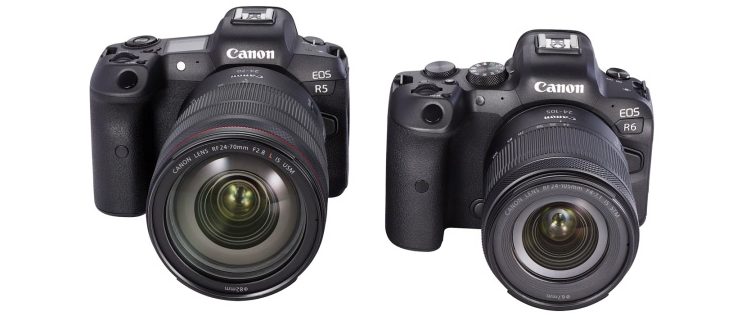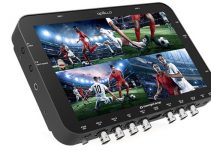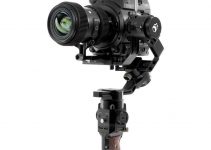At a point in time when professional DPs were gladly anticipating the death of DSLR video, Canon shocked our little world with the release of the EOS R5. With spotlight-stealing headlines like 12-bit 8K Raw recording, a lot of people missed the simultaneous announcement of the EOS R6, the little brother who really packs a punch.
So what is the EOS R6, and how is it different from the R5? Aside from a massive price cut, how will this camera work for videographers and independent filmmakers, if at all? There are still a lot of unknowns since not very many people have had the opportunity to film with it, but our friends over at CVP have put together all the information you need to know about this enticing new camera.
One of these things is certainly not like the other. The EOS R5 is Canon’s flagship, full-frame RF model camera, and the EOS R6 (despite being given a higher number) is built and intended as a budget or entry-level full-frame camera.
They didn’t make budget cameras like this back in my day, though. (I’m not really that old, its just cameras get churned out so quickly now. In camera-years, I’m like 250.). Let’s have a look at some of the features for the EOS R5 and the EOS R6.

EOS E5 Key Features
- 45MP Full-Frame CMOS Sensor
- DIGIC X Image Processor
- 8K30 Raw and 4K120 10-Bit Internal Video
- Sensor-Shift 5-Axis Image Stabilization
- Price: $3,899
EOS R6 Key Features
- 20MP Full-Frame CMOS Sensor
- DIGIC X Image Processor
- 4K60p and FHD 120p 10-Bit Internal Video
- Sensor-Shift 5-Axis Image Stabilization
- Price: $2,499
Resolution
The first thing you’ll notice is that the R6 has a lot lower stills resolution than the EOS R5. The 20MP R6 shoots at roughly 45% of the image quality as it’s big brother, the 45MP R5. This might not be a bad thing, however, since that lower megapixel count could, in theory, mean that the R6 actually has larger photosites meaning that it could (potentially) best its big bro in low light performance.
There is surely some exclusive imaging technology in the amazing sensor they’ve placed in the EOS R5, but interestingly the R6 uses the same Digic X imaging processor. The powerful Digic X is the key that allows the R5 & the R6 to do everything that they do.
Both cameras are lighting fast stills cameras, capable of shooting 20 FPS full resolution stills, feature 1053 autofocus points, and are fine tuned to aid the professional and hobbyist photographer to react quickly in the moment. But we’re 4kshooters, not 4kclickers, photo features are great but where we begin to see the largest schism between these cameras is in their video recording formats.
Video Features
Right here is where the price difference really becomes apparent. The R5 blew people away with it’s 8K DCI Raw recording resolution, so much so that the 10-Bit 4K 60p didn’t really even make a splash. In fact, my own first thought was “so why couldn’t you put 10-bit in my beloved C200, Canon?”
Canon EOS R5 Video Resolutions
- Raw 12-Bit
- DCI 8K (8192 x 4320) at 23.976p/24.00p/25p/29.97p [2600 Mb/s]
- H.265 4:2:2 10-Bit
- DCI 8K (8192 x 4320) at 23.976p/24.00p/25p/29.97p [680 to 1300 Mb/s]
- UHD 8K (7680 x 4320) at 23.976p/25p/29.97p [680 to 1300 Mb/s]
- DCI 4K (4096 x 2160) at 23.976p/24.00p/25p/29.97p/59.94p/100p/119.88p [170 to 1880 Mb/s]
- UHD 4K (3840 x 2160) at 23.976p/25p/29.97p/50p/59.94p/100p/119.88p [170 to 1880 Mb/s]
- Full HD (1920 x 1080) at 23.976p/25p/29.97p/50p/59.94p [28 to 230 Mb/s]
- H.264 4:2:0 8-Bit
- DCI 8K (8192 x 4320) at 23.976p/24.00p/25p/29.97p [470 to 1300 Mb/s]
- UHD 8K (7680 x 4320) at 23.976p/25p/29.97p [470 to 1300 Mb/s]
- DCI 4K (4096 x 2160) at 23.976p/24.00p/25p/29.97p/50p/59.94p/100p/119.88p [120 to 1880 Mb/s]
- UHD 4K (3840 x 2160) at 23.976p/25p/29.97p/50p/59.94p/100p/119.88p [120 to 1880 Mb/s]
- Full HD (1920 x 1080) at 23.976p/25p/29.97p/50p/59.94p [12 to 180 Mb/s]
Canon EOS R6 Video Resolutions
- H.265 4:2:2 10-Bit
- UHD 4K (3840 x 2160) at 23.976p/29.97p/59.94p [170 to 340 Mb/s]
- Full HD (1920 x 1080) at 23.976p/29.97p/59.94p/119.88p [28 to 180 Mb/s]
- H.264 4:2:0 8-Bit
- UHD 4K (3840 x 2160) at 23.976p/29.97p/59.94p [120 to 230 Mb/s]
- Full HD (1920 x 1080) at 23.976p/29.97p/59.94p/119.88p [12 to 120 Mb/s]
The EOS R6 is limited to only shooting in IBP in all video modes, and ALL-I only in time lapse mode. Whereas, the R5 can shoot in a variety of formats, including RAW, and it’s time lapse function can also be captured in 8K raw.
Additionally, the R5 can record and output simultaneously to an external recorder giving you the ability to film in both raw and capture a fantastic 4K 10-bit image on your Atomos for faster turnarounds in post. Sadly, the ability to record both internally and externally at the same time isn’t available on the R6.
Both cameras feature Clog and HDRPQ recording; however, the R6 can only utilize these features in manual mode.
Dual Pixel Auto-Focus
Canon has implemented DPAF with 1053 points in both the R6 & R5, and for me this is the number one feature to have in any camera. As an often solo shooter, I’ve always found my weakness to be focus pulling (especially when there are 40 other things on my mind).
Canon’s DPAF is phenomenal with the right lenses; it also saves me a ton of time on retakes, and lets me acquire shots I otherwise wouldn’t have been able to do without a crew.
I was elated to hear that DPAF was available in both cameras, and I assume that the increase in low-light performance on the R6 will make autofocusing even better.
5 Axis Image Stabilization
On top of DPAF, both cameras feature the same 5-Axis in-camera image stabilization which will keep your handheld work looking smooth and shake-free.
Physical Differences
The R6 is slightly lighter than the R5, at 1.5lbs compared to 1.62lbs, and is made from a polycarbonate material rather than the high-end magnesium alloy that surrounds the R5. It feels noticeably cheaper in the hand, like the difference between a Rebel line camera and a 5DMKIV but still well constructed and ready to face the wears of a challenging shooting environment.
The R6 lacks the fantastic top screen we see in the R5, opting for a more traditional mode dial instead but otherwise grip and button placements are similar and familiarly Canon.
There are differences in the card slots used in the Cameras too. The R5 has 1 x CFexpress slot and 1x SD slot, and the R6 has 2x SD slots.
The EVF and screen resolution is another area where Canon cut back to make the R6 more affordable, giving the R6 a 3.69m-DOT OLED EVF compared to the R5’s 5.76m-Dot OLED EVF, and a 3” 1.62m LCD compared to the R5’s 2.1m LCD.
Other physical differences include a 3.5mm remote port on the R6 instead of a flash sync point on the R5.
The R6 also lacks the 5ghz WiFi of the R5 and can only use 2.4ghz WiFi. This means the Canon should have similar WiFi range to the R5 but slower speeds.
Conclusion
Overall, the R5 was built with a professional photographer in mind and surgically designed to get them out of the EF realm and into the new RF standard by packing amazing features into a camera they’ll use for a long time. The R6 was made for the hobbyist, the prosumer, and the proud Mom/Dad with deep pockets.
Even though the video features on the R6 might not be as jaw dropping as the R5, they still represent a turn for Canon and could definitely find their place on a video or film shoot.
Things are just starting to heat up about these two cameras, and we’ll be able to see their performances differences more clearly when they find their way into our hands.
If you need to shoot 8K raw on a mirrorless camera, the R5 might be perfect for you but the R6 offers a fantastic compression codec and likely won’t overheat and shutdown every 20 minutes like the R5 – ouch!.
[source: CVP]
B&H Order Links:
Canon EOS R5 Mirrorless Digital Camera
Canon EOS R6 Mirrorless Digital Camera
Disclaimer: As an Amazon Associate partner and participant in B&H and Adorama Affiliate programmes, we earn a small comission from each purchase made through the affiliate links listed above at no additional cost to you.



